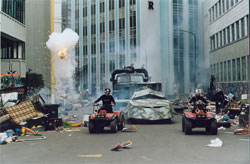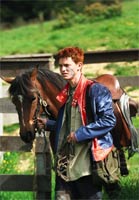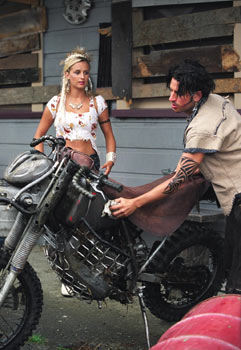 You can track man’s progress by the way he makes his way through the world.
You can track man’s progress by the way he makes his way through the world.
There was a time when the only way to get from place to place was to take yourself there—on foot. What did this mean? Don’t wander far from home, kid. Moving on foot has some immediate consequences on your way of life.
There are two choices: You can choose to stay within about 10 km of your home at all times. You live in a closed, familiar world with –hopefully!— everything you’ll need within easy reach. Your life is steady, constant, relatively homogenous.
….Or you can choose to forsake house and home. You live the life of a wanderer. Everything is new to you, and you are solving different problems every day, constantly redefining the way that you will satisfy basic needs such as food, water, shelter, and human company or enemies.
Either way, at the end of the day your calves are sore and your feet ache.
Of course this could not last forever, and the sore-footed people of the world decided to unite. So they wrangled up some roaming animals in the area, and let the animals to the walking….and the aching.
Suddenly it was possible to cross several times the distance a person could walk on his own, to gallop easily across a plain, or carry loads too heavy for one person. People were free to explore much larger areas, to meet a more diverse group of people, to trek from one village to another without having to rough it for a few nights in the space between.
 But people were still limited by the animal’s limitations. They could move greater distances, but were hindered in their travels by the limitations of the creature’s stamina, as well as its ability to carry large loads.
But people were still limited by the animal’s limitations. They could move greater distances, but were hindered in their travels by the limitations of the creature’s stamina, as well as its ability to carry large loads.
You know what comes next. The Wheel~! Hand drawn carts. Horse and buggy carriages. Suddenly people were able to bring more with them as they made their way in the world, could transport goods for trade to a neighbouring town, or could bring their possessions on a journey, packing food and clothing so that the necessities were not such a pressing issue during travels. Or they could even travel in small groups, shoving a whole family into a wagon or carriage.
Even short journeys were made easier by covered wagons. Whereas, in the past, any movement was subject to climactic conditions, people could now sit inside their carts, out of the wind and rain, leaving only their poor beasts of labour to suffer the actual conditions of the weather.
Then there were means of transportation that did not directly require the labour of people or animals. Ships crossed waters using wind rather than the muscled-oaring of smaller, more primitive boats. On ships, large numbers of people could move about from place to place, or large amounts of goods could be transported, allowing trade to occur across great areas. People were no longer concerned with necessities, but could indulge in fascinating foreign products—textiles, spices…..even, regrettably, human slaves.
And then trains ran on set tracks using burning coal to set wheels in motion, moving people and goods to once impossible-to-reach areas on land.
Mass transportation and trade vastly expanded the world from the outlook of the individual. People began to think globally. Communication methods had to keep up with transportation. Specially couriered mail gave way to massive postal systems, the telegraph and the telegram were created, even the telephone.
And then something changed. Whereas until this pint in time, developments in the field of transportation were creating larger and larger transporters, able to move more and more people or products at a time, the gas-powered car shrunk that outlook back to a smaller scope. A car could carry a family. People were free to travel in private again, to travel great distances, unhindered by the capabilities of their horses. They could take the path that they chose, unhindered by train schedules and routes, and get there rapidly. As the car became more common people could work farther from home, live farther from the store, were granted a delicious amount of freedom…..at the cost of the environment.
As we now know, nothing is free of cost. Using substance-powered vehicles seemed like a perfect solution to the imperfection of animals. But coal and gasoline have wreaked havoc on our environment, destroying the land where the coal and oil are sourced, polluting the air into which the carbon fumes are expelled.
 Recently, there has been a bit of a resurgence of mass transportation. Busses transport many more people at a time on the same tank of petrol. Localized trains and subways transport even more people at a time, often using electrical power, rather than coal or petrol (of course the electricity does not come at a cost, and somewhere a nuclear power plant or a coal power plant is hard at work, creating the electrical current that surges through the city). And, of course, airplanes take a large amount of people from place to place, by the most direct route—a straight line.
Recently, there has been a bit of a resurgence of mass transportation. Busses transport many more people at a time on the same tank of petrol. Localized trains and subways transport even more people at a time, often using electrical power, rather than coal or petrol (of course the electricity does not come at a cost, and somewhere a nuclear power plant or a coal power plant is hard at work, creating the electrical current that surges through the city). And, of course, airplanes take a large amount of people from place to place, by the most direct route—a straight line.
Power and Chaos!
It is not enough to move a lot of people at a time. The energy sources we use today are not endless, in fact, they are due to run out within the next 20 years. It is time to look at the alternatives.
Electric cars and hybrids are gaining popularity, especially for public vehicles in some areas. But is there a clean source of electricity? Solar power is a great resource, however, to harvest it requires vast solar panels. To power an entire city using solar energy might require the streets to be paved with solar panels, or….(perhaps more practically) the roofs to be covered.
Wind power is another great natural resource, but wind-harvesting is imperfect, and engineers are continuing to struggle with efficient means to tap the power of the wind. Entire fields of surreal windmills are not yet enough to power a small city.
And then there’s hydrolic power; again, a great natural source, still being perfected.
Unfortunately, all of these alternative sources of power would require great expense to develop and implement for the first time. Once implemented though, you can be sure we wont exhaust our supply of sun, wind and rain…..for a very, very long time.
Until then, perhaps the best source of transportation is still your own two feet—and a good bike.
TribeWorld
The kids in Tribeworld experience these issues with transportation to a much more intense degree. Children do not have the skills or know-how to harvest oil—thus petrol is a much more valuable, limited resource. As such, substance-powered vehicles are quite a rare commodity. Most people move about on foot, although there is the occasional bus that Ebony happens to have hidden away for a rainy day, or horse that KC happens to trade on a big day out. Slade owns a motorcyle and The Techno’s seem to have a few trucks but finding petrol for them must be difficult and expensive because there won’t be much around.
Again, the amount of space that a person can travel is extremely limited. Kids can never wander too far from home, for fear being stuck somewhere strange, in grave danger. The kids in Tribeworld are rediscovering their options for movement, and redefining their sense of space from a much more localized perspective.
Suddenly the world of the children has become much smaller, and the planet much, much bigger.

